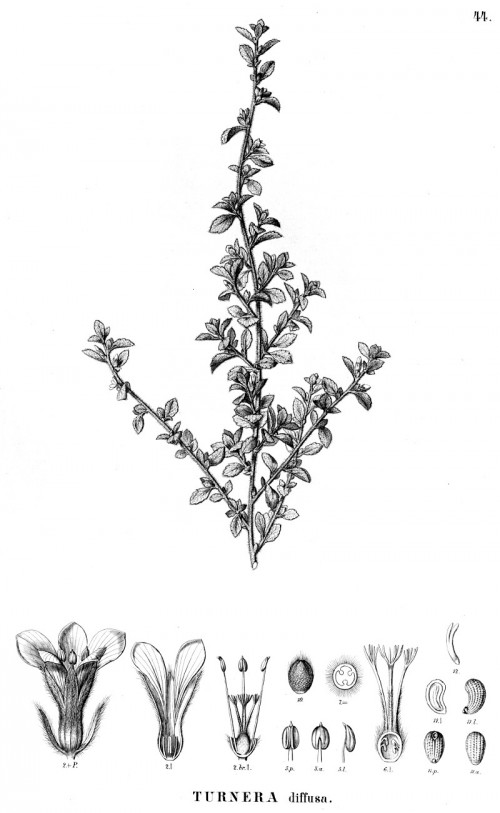Turnera diffusa Willd. - syn.Turnera microphylla Ham. - Turneraceae
damiana, Mexican holly, (Schmalblättrige) Damiana
Small evergreen shrub, up to 2m high, native to Central America; leaves ovate to obovate, serrate, aromatic; flowers yellow.
Turnera aphrodisiaca = Turnera diffusa Willd. var. aphrodisiaca
The plant contains a cyanogenisc glycoside, tetraphyllin B.
[Tetraphyllin B from Turnera diffusa., Spencer, K., Seigler, D.S., Planta medica, Vol.43, 1981, 175-178]
„The infusion of the aerial parts of Turnera diffusa was phytochemically examined. Chromatographic procedures led to the isolation of a new flavone glycoside, five known flavonoids and p-arbutin.“
[Flavonoids and arbutin from Turnera diffusa., Piacentea, S., Camargob, E.E., Zampellia, A., Graciosoc, J.S., Britoc, A.R.S., Pizzaa, C., Vilegasd, W., CEP, 14801, 2002, 902]
http://www.znaturforsch.com/ac/v57c/s57c0983.pdf?q=diffusa
„Damiana is claimed to be a stimulant and aphrodisia… It is considered useful for countering fatigue, overwork, depression and stress. In aromatherapy, the essential oil is considered to be uplifting. In Mexico, an infusion is drunk like ordinary black tea…
Arbutin is known as a diuretic and urinary tract desinfectant but the levels in damiana are considered too low to be therapeutically significant.“
[Medicinal Plants of the World. Ben-Erik Van Wyk and Michael Wink, Pretoria 2004, 327]
Folia (Ramuli) Damianae, the dried leaves of T.diffusa, own a citric scent and a aromatic bitter taste. They contain essential oil (0.5-0.9%), tannins (3.5%) and bitter substances (up to 7%). The infusion is used in Mexico as (heart) tonic, stimulant, aphrodisiac and diuretic.
[Hagers Handbuch der Pharmazeutischen Praxis, Springer 2010]
„Plants of damiana(Turnera diffusa Willd.) are important to industry and traditional medicine in semi-arid climates. Although all populations are wild, no reports have been made previously of their different phenotypes. Here, we investigated various micromorphological characteristics and the levels of essential oils in two phenotypes. Oils were extracted from fresh leaves via hydrodistillation and analyzed by gas chromatography-mass spectrometry. Morphological analyses were conducted under a stereoscopic microscope and with a scanning electron microscope. In all, 56 compounds were identified, enabling us to distinguish separate phenotypes. DL1 plants mainly contained 1,8-cineole, 10-epi-gamma-eudesmol, and guaiol; whereas those of DL2 primarily constituted ß-pinene, ß-caryophyllene oxide, cadinene, and α-cadinol. These two phenotypes also differed in their morphologies, with DL1 leaves showing elevated essential oil concentrations, but lacking trichomes. In contrast, the DL2 plants had lower contents of essential oils but did possess trichomes on their abaxial and adaxial leaf surfaces.“
[Differences in essential oil production and leaf structure in pheno-types of damiana(turnera diffusa willd., Lilia Alcaraz-Meléndez, Sergio Real-Cosío, Václav Suchý, Emil Švajdlenka, Journal of Plant Biology, Vol.50(3), 2007, 378-382]
The plant contains apigenin, which showed antianxiety activity in tests with mice.
[Pharmacological evaluation of bioactive principle of Turnera aphrodisiaca., Kumar, S., Madaan, R., Sharma, A., Indian journal of pharmaceutical sciences, Vol.70(6), 2008, 740]
http://www.ncbi.nlm.nih.gov/pmc/articles/PMC3040867/
„Turnera diffusa and sildenafil (both at 10 mg/kg) facilitated expression of male sexual behavior by shortening mainly ejaculation latency. Treatments also facilitated the number of discharges in the ejaculatory motor pattern as well as the number of ejaculatory motor patterns and its associated penile erections. l-NAME prevented the pro-sexual effects of treatments on both experimental models. Besides, the extract of Turnera diffusa (10 mg/kg) produced an anxiolytic-like effect in male rats without affecting ambulation.“
[Pro-sexual effects of Turnera diffusa Wild (Turneraceae) in male rats involves the nitric oxide pathway., Estrada-Reyes, R., Carro-Juárez, M., Martínez-Mota, L., Journal of ethnopharmacology, Vol.146(1), 2013, 164-172]
„While not listed in the famous Cruz and Badiano libellus medicinalibus indorum herbis from 1552, which describes and depicts many medicinal plants used in pre-Hispanic times in Mexico, Turnera diffusa was nonetheless used by North American Indians since times immemorial as a tonic for muscle weakness and to regain strength after alcoholic and sexual excesses…
Turnera diffusa [is] one of the species having been evaluated negatively due to missing data on efficacy (but not because of any known risks) by the Commission E of the German Bundesinstitut für Arzneimittel und Medizinprodukte…
Ideally, double blind studies with standardized damiana extracts in comparison to another non-aphrodisiac herbal extracts should be performed on damiana naive human subjects. As Estrada-Reyes et al. (2013) proved an involvement of the NO-pathway for the aphrodisiac activity of damiana, it is reasonable to focus the first wave of future studies in this area on the cyanogenic glucoside found in Turnera diffusa.“
[Ethnobotany, phytochemistry, and bioactivity of the genus Turnera (Passifloraceae) with a focus on damiana—Turnera diffusa., Szewczyk, K., Zidorn, C., Journal of ethnopharmacology, Vol.152(3), 2014, 424-443]
http://www.drlowdog.com/Assets/pdf_files/FIHM_online_docs/fihm_part_3/fihm_14_womens_health_2/Handouts/Turnera_Review_2014.pdf

Martius, C., Eichler, A.G., Urban, I., Flora Brasiliensis, vol.13(3): f.91, t.44 (1883)
http://plantgenera.org/species.php?id_species=1039899
